What Is a Tully Monster? Scientists Finally Think They Know
The oddball fossil that puzzled experts for almost 60 years is probably an ancient fish akin to today’s bloodsucking lampreys
/https://tf-cmsv2-smithsonianmag-media.s3.amazonaws.com/filer/f7/7f/f77f4b7a-667a-46c0-aaac-31a346639798/tully-short.jpg)
The worm-like creatures writhed in the dark waters, fins twitching and eyestalks roving. Each one sported a long, pincher-tipped proboscis lined with tiny, needle-like teeth. When paleontologists found fossils of these ancient horrors trapped in stone, they named them Tullimonstrum gregarium, or Tully monsters.
For roughly 60 years, no one could say for sure what the strange beasts actually were. Paleontologist Eugene Richardson, who gave the species its name in 1966, was so unsure of the creature's nature that he wasn’t confident sticking it within any known lineage beyond “animal.”
Now, an international team says they have at last cracked the mystery, and their answer overturns every other theory offered to date. Depending on who you asked, the Tully Monster could have been related to ribbon worms, snails, eel-like protovertebrates called conodonts or other ancient oddballs, like another nozzle-nosed creature called Opabinia. But based on studies of more than 1,200 fossil specimens, the researchers say the Tully Monster was really a vertebrate, specifically, a type of fish akin to modern lampreys. If they're right, the fossil changes what we know about the history of these aquatic bloodsuckers.
“Instead of being a small, conservative lineage of bloodsucking fish, lampreys are inferred to have undergone a dramatic diversification, achieving some outlandish body plans and long forgotten modes of life,” says University of Manchester paleontologist Rob Sansom.
Found by the dozens in the roughly 300-million-year-old rock of Mazon Creek, Illinois, the Tully Monster was a tiny terror—the largest specimens stretch a little more than a foot long. But they have an outsized appeal to paleontologists, and have even been named the official state fossil of Illinois.
For decades the prehistoric whatsit remained a frustrating enigma, and was so weird that it even skirted the edges of myth. Some cryptozoologists became enamored with the idea that the legendary Loch Ness Monster was a supersized version of Tullimonstrum.
Yale University paleontologist Victoria McCoy says that she’s always had a soft spot for the Tully Monster, in part because the creature stood out as something very different from anything alive today. Given that there are thousands of specimens from a time when the major branches of animal life were already in place, she felt there was a good chance of solving the mystery.
As it happens, the key was staring paleontologists in the face all along. Although the weird eyestalks and flexible snoot are the most obviously bizarre features of Tullimonstrum, paleontologists were puzzled by what they previously interpreted as the “gut trace.” Other animals from the same rock have gut contents that are preserved as dark, mineralized sections, but the guts of the Tully Monster were different. It appeared as a lightly colored, flattened structure that ran from the eye stalks to the end of the tail.

That was odd, because the gut should not continue past the end of the tail in both vertebrates and mollusks, McCoy noted. The pale line had to be something else. While McCoy was reading up on other Mazon Creek fossils, including fossil lampreys and hagfish, she realized that these vertebrates had the same structure: a notochord. This is what drew the mysterious creature into the vertebrate family tree.
“Lampreys are vertebrates,” McCoy says, “so the Tully was as well.”
From there, the stranger features of the Tully Monster started to fall into place. In addition to a notochord, “the Tully Monster also has large complex eyes, horny teeth, a tail fin with fin rays and a tri-lobed brain,” McCoy says. These features aren’t always unique to vertebrates, but they nevertheless fit with the new identification.
Likewise, recent research on how animals like modern lampreys decay showed that the worm-like “segments” of the Tully Monster are really slightly decayed muscles that match up with those of early fish. Suddenly all the pieces snapped into focus, allowing McCoy and her co-authors to finally identify the Tully Monster, as they report this week in Nature.
The result was “quite surprising and raises a lot of interesting questions,” says Sansom, who was not part of the research team. While the Tully Monster shows some traits in common with vertebrates, there are still some “extraordinarily bizarre” parts of its anatomy that are unlike any other vertebrate, he adds.
“There are currently no known mechanisms by which a jawless vertebrate could develop eyes on stalks or jaws on a long proboscis,” Sansom says, opening up mysteries about how the Tully Monster came to be. Given that the lamprey fossil record is sparse, further surprises might await in the rocks below.
For now, though, thanks to the efforts of McCoy and her colleagues, another oddball finds its place on the Tree of Life, matched to the greater vertebrate branch to which we also belong. But, as its scientific name implies, the creature is still worthy of the title "monster."
/https://tf-cmsv2-smithsonianmag-media.s3.amazonaws.com/accounts/headshot/RileyBlack.png)
/https://tf-cmsv2-smithsonianmag-media.s3.amazonaws.com/accounts/headshot/RileyBlack.png)